NCERT Solutions for Class 10 Science Chapter 10 Light Reflection and RefractionCandidates can lay a solid foundation in Physics by working through the easy chapter of the class 10 NCERT answers. Understanding the class 10 questions and answers for light reflection and refraction can assist students in class 10 achieve a respectable grade in the class 10 board examinations as well. 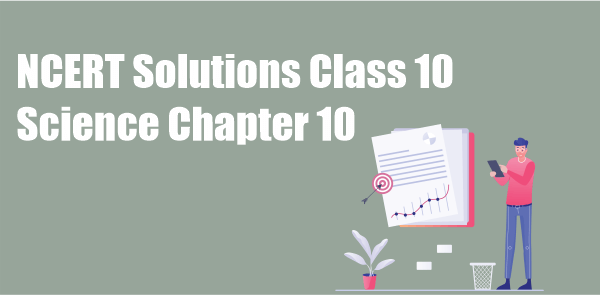
Candidates can also discover light reflection and refraction class 10 numericals questions in this post along with NCERT Solutions for Class 10 Science Chapter 10 Light Reflection and Refraction. Candidates who will read these solutions will have a clear understanding of how to approach the questions, which will help them to solve questions or numericals as quickly as possible. NCERT Solutions for Class 10 Science Chapter 10 Inside Chapter QuestionsPage Number: 168Question 1: Define the principal focus of a concave mirror. Answer: A concave mirror's principal focus is a location on its principal axis where all parallel and near-axis light rays converge after being reflected by the concave mirror. Question 2: The radius of curvature of a spherical mirror is 20 cm. What is its focal length? Answer: 
Question 3: Name a mirror that can give an erect and enlarged image of an object. Answer: Concave mirror can give an erect and enlarged image of an object. Question 4: Why do we prefer a convex mirror as a rear-view mirror in vehicles? Answer: For two reasons, we like convex mirrors as rear view mirrors in automobiles: i.) An object's image is always erect in a convex mirror. ii.) A convex mirror provides a broad field of vision of the traffic behind it since the image generated in it is greatly decreased or considerably smaller than the object. The driver can see a wider area of the traffic behind him thanks to a convex mirror. Page Number: 171Question 1: Find the focal length of a convex mirror whose radius of curvature is 32 cm. Answer: 
Question 2: A concave mirror produces three times magnified (enlarged) real image of an object placed at 10 cm in front of it. Where is the image located? Answer: The image formed in this case is a real image, hence we can conclude that magnification m should be negative. 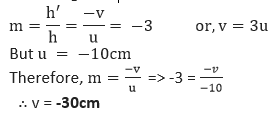
Thus, from our result we can say that the location of image is on the mirror's side and I is at a distance of 30cm from the mirror. Page Number: 176Question 1: A ray of light travelling in air enters obliquely into water. Does the light ray bend towards the normal or away from the normal? Why? Answer: The ray of light travelling in air enters obliquely in water and the light-ray bends towards the normal because the ray of light goes from a rarer medium to a denser medium. Question 2: Light enters from air to glass having refractive index 1.50. What is the speed of light in the glass? The speed of light in vacuum is 3 x 108 ms-1. Solution: Refractive index of glass, ng = 1.50 Speed of light in vacuum, c = 3 * 108 ms-1 
Question 3: Find out, from Table 10.3, the medium having highest optical density. Also find the medium with lowest optical density. Answer: In table 10.3, the diamond has the highest refractive index which is 2.42, therefore it has highest optical density. The lowest refractive index is of air which is 1.0003, therefore it has the lowest optical density. Question 4: You are given kerosene, turpentine and water. In which of these does the light travel fastest? Use the information given in Table 10.3. Answer: For kerosene, n = 1.44 For turpentine, n = 1.47 For water, n = 1.33 Water is optically rarer than kerosene and turpentine oil, therefore light moves faster there because it has the lowest refractive index. Question 5: The refractive index of diamond is 2.42. What is the meaning of this statement? Answer: When we remark that a diamond has a 2.42 refractive index, we are referring to the fact that the speed of light in diamond is 2.42 times slower than it is in a vacuum. Page Number: 184Question 1: Define 1 dioptre of power of a lens. Answer: One dioptre is the power of a lens whose focal length is 1 metre. Question 2: A convex lens forms a real and inverted image of a needle at a distance of 50 cm from it. Where is the needle placed in front of the convex lens if the image is equal to the size of the object? Also, find the power of the lens. Solution: Here ν = +50cm Here in this case, the size of the real image formed is same as that of object so, 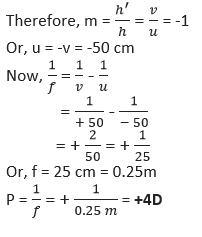
Question 3: Find the power of a concave lens of focal length 2m. Solution: It is clear that focal length of this concave lens is negative so, ∴ f = -2 m 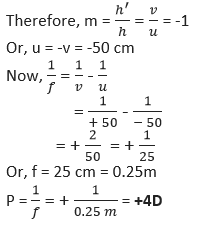
NCERT Solutions for Class 10 Science Chapter 10 Exercise QuestionsQuestion 1:Which one of the following materials cannot be used to make a lens?
Answer: d.) Clay Question 2: The image formed by a concave mirror is observed to be virtual, erect and larger than the object. Where should be the position of the object?
Answer: d.) Between the pole of the mirror and its principal focus. Question 3: Where should an object be placed in front of a convex lens to get a real image of the size of the object?
Answer: b.) At twice the focal length. Question 3: Where should an object be placed in front of a convex lens to get a real image of the size of the object?
Answer: b.) At twice the focal length. Question 5: No matter how far you stand from mirror, your image appears erect. The mirror is likely to be
Answer: d.) Either plane or convex. Question 6: Which of the following lenses would you prefer to use while reading small letters found in a dictionary?
Answer: c.) A convex lens of focal length 5 cm. Question 7: We wish to obtain an erect image of an object, using a concave mirror of focal length 15 cm. What should be the range of distance of the object from the mirror? What is the nature of the image? Is the image larger or smaller than the object? Draw a ray diagram to show the image formation in this case. Answer: A concave mirror gives an erect image when the object is placed between the focus F and the pole P of the concave mirror, i.e., between 0 and 15 cm from the mirror. The image thus formed will be virtual, erect and larger than the object. 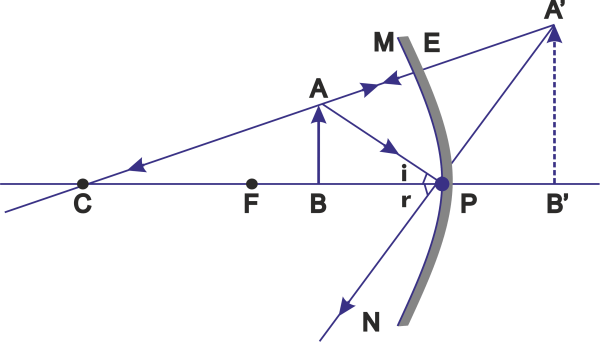
Question 8: Name the type of mirror used in the following situations:
Support your answer with reason. Answer: a.) Concave mirrors are used as reflectors in headlights of cars. When a bulb is located at the focus of the concave mirror, the light rays after reflection from the mirror travel over a large distance as a parallel beam of high intensity. b.) A convex mirror is used as a side/rear-view mirror of a vehicle because:
c.) Large concave mirrors are used to concentrate sunlight to produce heat in solar furnaces. Question 9: One-half of a convex lens is covered with a black paper. Will this lens produce a complete image of the object? Verify your answer experimentally. Explain your observations. Answer: A convex lens forms complete image of an object, even if its one half is covered with black paper. It can be explained by considering following two cases: Case I: When the upper half of the lens is covered In this case, a ray of light coming from the object will be refracted by the lower half of the lens. These rays meet at the other side of the lens to form the image of the given object, as shown in the following figure. 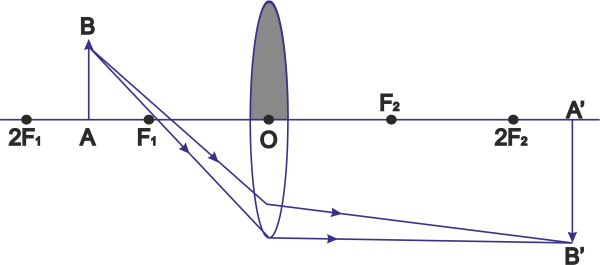
Case II: When the lower half of the lens is covered In this case, a ray of light coming from the object is refracted by the upper half of the lens. These rays meet at the other side of the lens to form the image of the given object, as shown in the given figure. 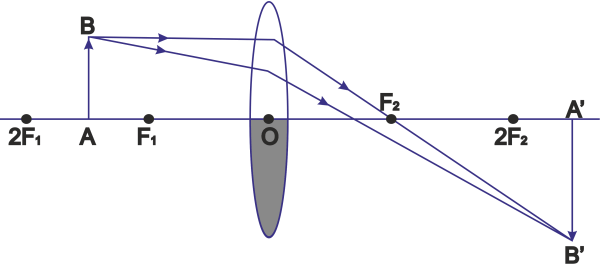
Question 10: An object 5 cm in length is held 25 cm away from a converging lens of focal length 10 cm. Draw the ray diagram and find the position, size and the nature of the image formed. Answer: Here: Object distance, u= -25 cm, Object height, h = 5 cm Focal length, f = +10 cm According to the lens formula, 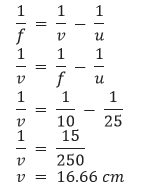
The positive value of v shows that the image is formed at the other side of the lens. 
The negative value of image height indicates that the image formed is inverted. The position, size, and nature of image are shown alongside in the ray diagram. 
Question 11: A concave lens of focal length 15 cm forms an image 10 cm from the lens. How far is the object placed from the lens ? Draw the ray diagram. Solution: Focal length, f = -15 cm, Image distance, ν = -10 cm (as concave lens forms the image on the same side of the lens) From the lens formula 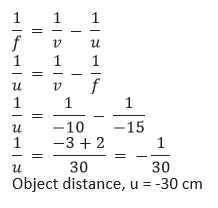
The negative value of u indicates that the object is placed in front of the lens. 
Question 12: An object is placed at a distance of 10 cm from a convex mirror of focal length 15 cm. Find the position and nature of the image. Solution: Object distance, u = -10 cm, Focal length, f = +15 cm, Image distance, ν = ? We know that, 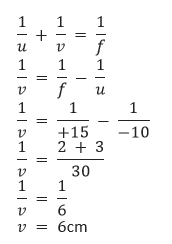
Thus the distance of image is +6 cm and also v is positive therefore the type of image formed is virtual image which is at a distance of 6 cm behind the mirror. 
Since we got a positive value therefore we can conclude that the image formed is erect and smaller than the object because its value is less than 1. So the image formed will be virtual, erect and diminished. Question 13: The magnification produced by a plane mirror is +1. What does this mean? Answer: 
Given m = +1, so h' = h and v = -u Also the v and u have opposite signs which helps us to conclude that the image formed is virtual image and it is formed behind the mirror. Question 14: An object 5.0 cm in length is placed at a distance of 20 cm in front of a convex mirror of radius of curvature 30 cm. Find the position of the image, its nature and size. Solution: Since object size, h = +5 cm, object distance, u = -20 cm and radius of curvature, R = +30 cm 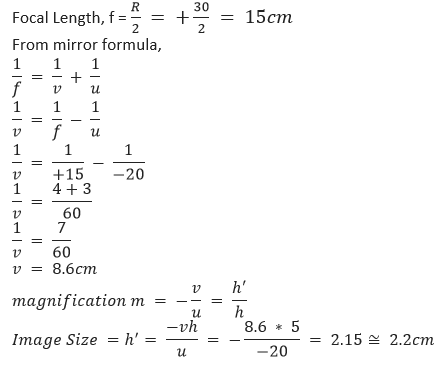
The location of the image formed will be behind the mirror because the type of image is erect and virtual. Image is located at a distance of 8.6 cm from the mirror and its height is 2.2cm. Question 15: An object of size 7.0 cm is placed at 27 cm in front of a concave mirror of focal length 18 cm. At what distance from the mirror should a screen be placed, so that a sharp focused image can be obtained ? Find the size and the nature of the image. Answer: Here, object size, h = +7.0 cm, object distance, u = -27 cm and focal length, f = -18 cm Image distance, ν = ? and image size, h' = ? From the mirror formula, 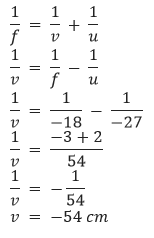
To obtain a sharp image the screen needs to be placed at a distance of 54cm from the object. 
Thus nature of the image is real, inverted and enlarged in size. Question 16: Find the focal length of a lens of power -2.0 D. What type of lens is this ? Answer: Here, P = -2.0 D As the focal length is negative therefore it's a concave lens. 
Question 17: A doctor has prescribed a corrective lens of power +1.5 D. Find the focal length of the lens. Is the prescribed lens diverging or converging ? Answer: Here, P = +1.5 D 
The lens prescribed here is converging because its focal length is positive.
Next TopicClass 10 Science Chapter 11
|
 For Videos Join Our Youtube Channel: Join Now
For Videos Join Our Youtube Channel: Join Now
Feedback
- Send your Feedback to [email protected]
Help Others, Please Share









